A Visit to Richmond’s Monument Avenue
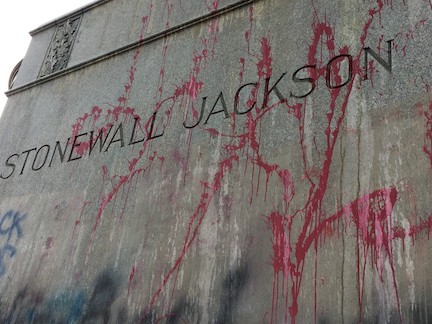 On Monday, June 22, I visited Richmond’s Monument Avenue to see for myself the effects of recent protests. You can see video from that trip on ECW’s YouTube page. What follows is an account of that trip. Some readers may find some of the language offensive.
On Monday, June 22, I visited Richmond’s Monument Avenue to see for myself the effects of recent protests. You can see video from that trip on ECW’s YouTube page. What follows is an account of that trip. Some readers may find some of the language offensive.
The exit ramp from I-95 deposits us onto Arthur Ashe Boulevard near the Diamond baseball stadium. A few blocks away, at the intersection with Monument Avenue, Stonewall Jackson waits for us. He, Lee, and the other Confederate monuments have stood for days at the center of controversy, and we have come to Richmond to see things for ourselves.
My two sons, 20-year-old Jackson and 3-year-old Maxwell, have made the trip with me. We plan to cruise the length of Monument Avenue and scope out the situation, and also find out how long the hike will be from Jeb Stuart’s monument at one end of the avenue to Matthew Maury’s at the other. I plan to park near one end, walk the length of the street to the other, and then double back. Along the way, we’ll bear witness to what’s been going AND get our daily exercise at the same time.
We park near a take-out noodle bar near Jeb Stuart Circle. As soon as we step out of the car, we see a spray-painted message on the sidewalk: “White silence = violence.”
We cross over to the equestrian statue at the center of the traffic circle. Stuart himself has a traffic cone atop his head. Dried red paint runs down his horse’s right haunch like blood from a battle wound, which isn’t all that far off the mark. Several strands of rope dangle from horse and rider like wet crepe paper streamers. It’s apparent someone had tried to pull this statue over and failed, but the ropes of the attempt remain.

The statue’s base has the graffiti equivalent of chicken-scratching spray painted all over it. “BLM”—“Black Lives Matter”—in black, white, and pink. I don’t know another common acronym, “ACAB,” which I only find out later means “All Cops Are Bastards.” I find this out because I ask my son, Jackson, who asks his sister, Stephanie, who is in law enforcement. That acronym suddenly stings because I know my daughter is not a bastard. How is that sort of stereotyping any different than the racial stereotyping protesters are upset about?
Other messages say “Defund hate” and “Say their name.” The name of Breonna Taylor, the EMT shot to death by police in her own Louisville apartment, appears in big white letters. There’s “Who’s Streets? Our Streets” and “Fuck Trump.” In fact, we’ll see the word “Fuck” so many times that one person who’ll later see my photos will say, “The protesters could benefit from a thesaurus.”
Another friend will seem shocked that I’ve taken my kids with me to bear witness. “I can’t believe you’d expose your youngest son to that kind of language!” he’ll say.
“He’s three. He can’t read yet,” I’ll reply. But if Maxwell was a little older, I would definitely be concerned about the language.
As the three of us walk northwest up Monument Avenue, we see houses with signs in their windows: “Don’t be sorry. Be better.” “Policies, not apologies.” “No justice. No peace. No racist police.” On one porch, a trio of twentysomething hipsters are passing a joint and people-watching as folks just like us walk up and down the street, taking in the sights.
As we near Lee Circle, orange spray paint on a sidewalk declares, “All lives can’t matter until black lives matter.”
We cross to Monument Avenue’s grass median and, from there, to Lee Circle itself, which is surrounded by concrete barriers. Each one bears a different spray-painted legend: “Solidarity,” “We have a dream,” “I can’t breathe,” and a lot of stuff I can’t make out. There’s even a mention of Tupac. I see “Stoney’s a bitch—also Trump!” and think at first it’s a reference to Stonewall Jackson only to then remember the mayor of Richmond is Levar Stoney.
A black man with no shirt and the athletic build of a martial artist steps into the flow of traffic to stop cars so we can cross the street and enter the park. “Thank you,” I tell him.
“Enjoy your day,” he says, stone-faced behind his sunglasses but polite.
When we get across the street, Jackson leans toward me. “Is that a sword he’s carrying?” he asks.
“It’s a katana,” I tell him—a Japanese style sword, safely in its sheath. It’s the only weapon we see all day, not brandished in any way that could be construed as intimidating. But it’s there.
If the circle were a clock and the statue of Robert E. Lee was facing noon, a cluster of camping tents huddles at around 10. A cluster of tents and pop-up canopies stretches from 4:30 to 6:30, with someone selling snacks and bottled water at one of them. At 11:30, a small walk-in tent advertises itself as a walk-in library: take a pamphlet, leave a pamphlet.
Lee, high enough atop his horse to be out of reach from all the paint, looks as regal as ever, staring fixedly off into the distance instead of down into the crowd that’s been making so much noise for so many days.
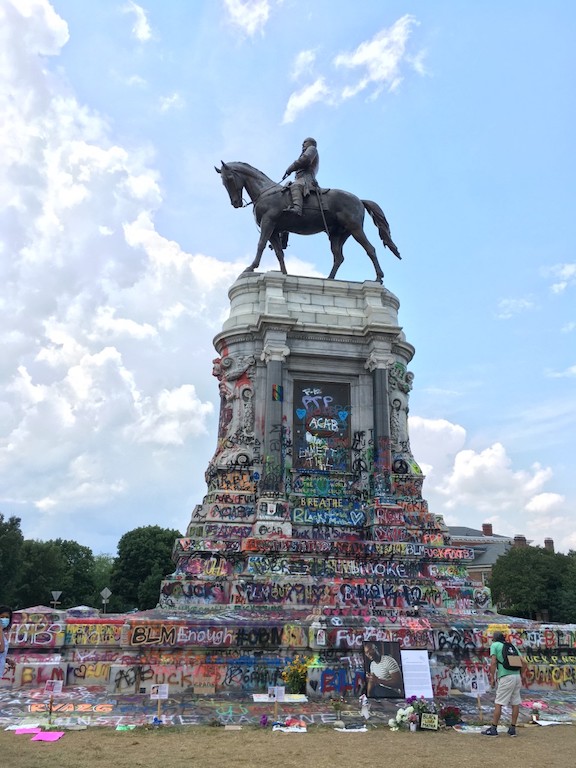
It’s much quieter today than it’s been at night: the grassy area around Lee’s statue feels like the third morning of a three-day music festival. Dozens of tourists, onlookers, rubberneckers, vigil-holders, and protestors mill about, individually or in small groups. Person after person steps up onto the stairs in front of the statue to have their photo taken. One woman in a purple dress raises her fist in a “black power” salute. She scowls when she sees me taking pictures but then stops when she realizes I was taking a picture of the statue, not her specifically.
What amazes me most are the layers upon layers upon layers of spray paint on every flat surface. In a way, the sheer volume of color is utterly beautiful. The messages, not so much. More f-bombs all over everything. But I also see “Uplift” and “Love” and “Listen.”
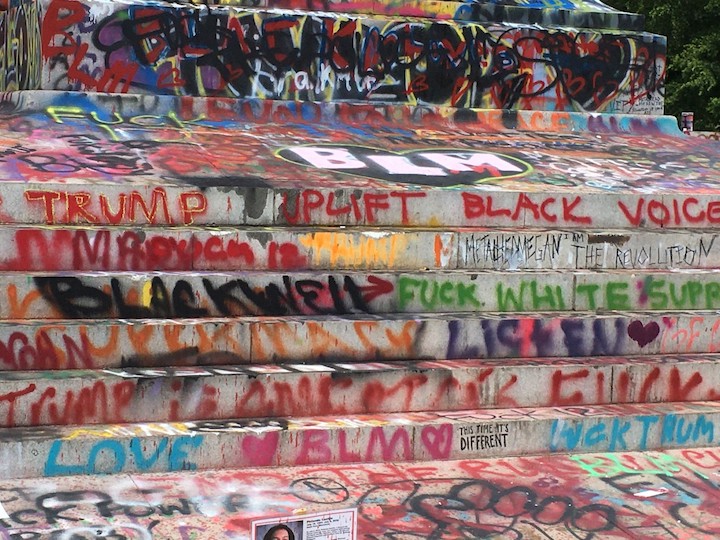
Someone climbed the front of the monument to paint “Proverb 29:16,” although because of the line break, it read “Pro verb,” a message that, as a writer, I can get behind because I’m definitely pro-verb. The impressions stays with me only a second before Jackson says he’s looked up the reference on his phone: “When the wicked thrive, so does sin, but the righteous will see their downfall.”
On the monument’s backside, a big smiley face dominates, but the scribbles and sprays of paint on the face’s yellow chin cascade down the monument in another torrent of color. I can’t even make out what most of it says, layer competing with overlying layer. The medium is the message here, even though the message also runs deeper, and I wonder how much of it is being drowned out by its own cacophony.
Around the base of the monument are two shrines to Marcus-David Peters, a 24-year-old biology teacher shot to death by police on I-95 in May 2018. Posterboards tell his story. Every two feet or so, a small sign staked into the ground tells the story of another black American shot by police. The signs wrap all the way around the monument, more than thirty in all, each with a story to tell. Mementoes, flowers, and messages cluster around the signs.
It’s hard to wrap my head or my heart around all this—and, yes, my heart is moved. I’m conflicted. On one hand, I see vandalism; on the other, I see so much raw hurt and anger. The anger, of course, is everywhere, visible most noticeably in all the F-bombs. The hurt—of an entire community, pent up for a century and a half and longer—is more sensed than seen, practically throbbing beneath all those colors. I wish more people could see past the paint and sense that, but I know many folks will only see the vandalism and be turned off, and not hear the primal scream it represents.
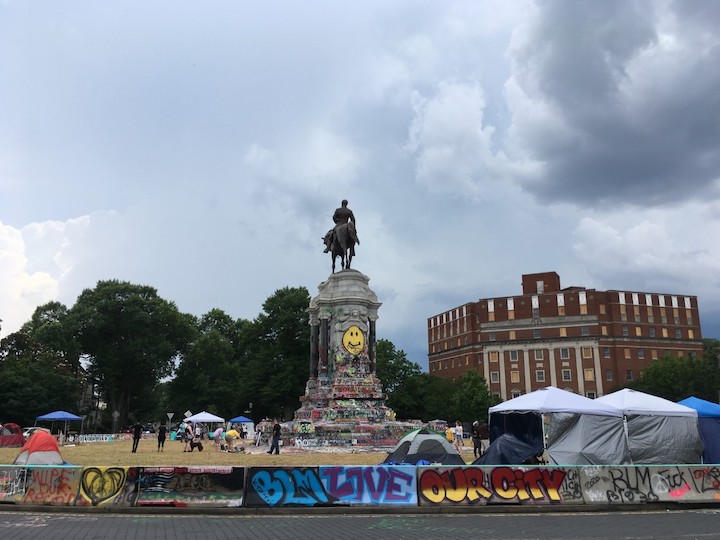
We leave the circle and start walking toward the next monument, but we see dark storm clouds looming to the west. A quick look at the radar on Jackson’s phone shows approaching thunderstorms. We decide to walk back to the car rather than walk on. We’ll drive to the rest of the monuments.
We park near the Jefferson Davis monument, although Davis has been gone for days, jerked down from his pedestal by protestors. An anarchy symbol now adorns the front of that pedestal along with “Amerikkka” and “Fuck Jeff Davis.” The base of the monument says “Cops ran us over.” There’s a spray-painted stencil of George Floyd’s face with the legend “I can’t breathe.” I still don’t get that one. Anyone who’s taken Heimlich maneuver training has learned that if you can speak, you can breathe, so I’m still not sure how Floyd could’ve spoken. I don’t say that to discount what happened to him or defend the officer accused of killing him. It’s just one part of the story I’ve not yet been able to understand, and now the story has become so shrouded in sensationalism that Floyd himself is as much a symbol as a person—in much the same way these Confederate statues are.
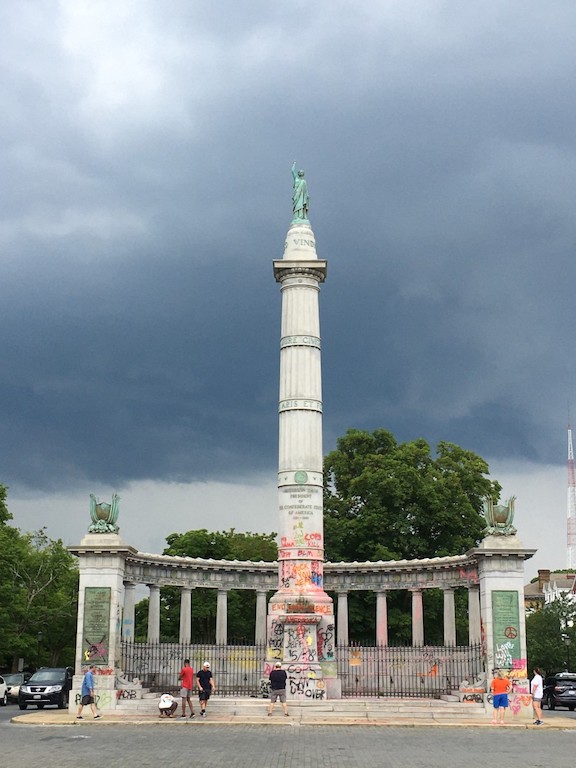
With the storm pending, the boys opt to stay in the car, so I inspect the monument on my own. Others walk up and read the graffiti, too. A girl in her late teens and her mother, a woman in her mid-40s, stand to one side of me, talking to each other. “And what did he do?” the girl asks her mom.
“Jefferson Davis?” I offer.
“Is that who this was?” the girl asks. “What did he do?”
I explain Davis’s pre-war role as a politician and Secretary of War, his role with the Confederacy, and the postwar controversy about his legal status. There are pros and cons. She can make up her own mind. She goes to read the original text of the monument, covered by the spray paint. Her mom, staying behind, thanks me. “How do we get them to learn this history?” she asks me, but I don’t know if she’s talking about young people like her daughter or protesters or who. The first drizzle starts to come down, so they retreat to their car and me to mine, where Jackson and Maxwell wait.
 Before I go, I notice one last spray-painted message that I really like because it’s a pop-culture reference to an Alan Moore graphic novel: “Who watches the Watchmen?”
Before I go, I notice one last spray-painted message that I really like because it’s a pop-culture reference to an Alan Moore graphic novel: “Who watches the Watchmen?”
Stonewall Jackson is next in line. I’m a Stonewall Jackson fanboy, and my 26-year-old daughter, Steph, has looked up to him as her hero since she was four—not because of his affiliation with the Confederacy but because he had a cool nickname. Her Spidey sense must’ve been tingling because, as I stood at the base of Jackson’s monument, she called me on Facetime so I could talk with my granddaughter. We used the opportunity for me to show Steph the graffiti on the monument. “Fuck this statue,” one vandal wrote. “No good cops,” wrote another. “ACAB” appeared several places, with the “A’s” replaced by the anarchy symbol.
“That’s terrible,” my daughter said, sobered by what she saw. “That’s terrible,” she repeated.
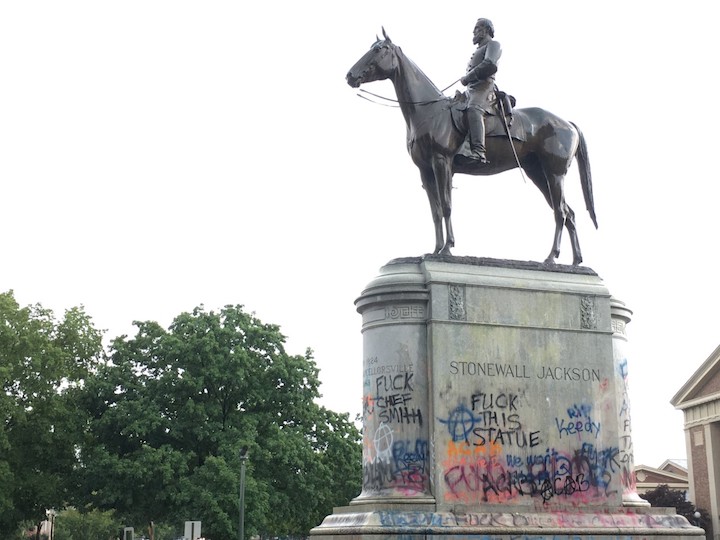
On the front of the monument, someone wrote “Fuck Chef Smith.” Wow, I thought, I don’t know who that chef is, but he must’ve cooked someone a really bad meal. Only on closer inspection did I see that “Chef” was actually “Chief,” and the reference was to Richmond’s chief of police.
By now the rain was coming in buckets, with flashes of lightning and deep rumbles of thunder. We had one final stop to make, at the statue for Matthew Fontaine Maury. Maury, known as the father of modern oceanography, was one of the foremost scientists in the world. In some ways, his statue is my favorite on Monument Avenue, not because of his service on behalf of the Confederate navy but because of his contributions to science. As a society, we don’t celebrate our scientists enough, so I’ve always been pleased that Maury merited a statue.
Protesters also thought he merited some attention, but the vandalism against his statue was mild compared to the others. It was like someone said, “Hey, Joe, go take Mary and Sam and run up the street and hit that last statue. What’s his name. What’s his name? The guy with the big ball or whatever. We have to hit them all, so you guys go get that one.” And Joe and Mary and Sam all went, “Awww, do we have to? Can’t we stay down here where all the cool stuff is going on?” And no, they couldn’t stay because they had to go spraypaint the statue of whatshisname.
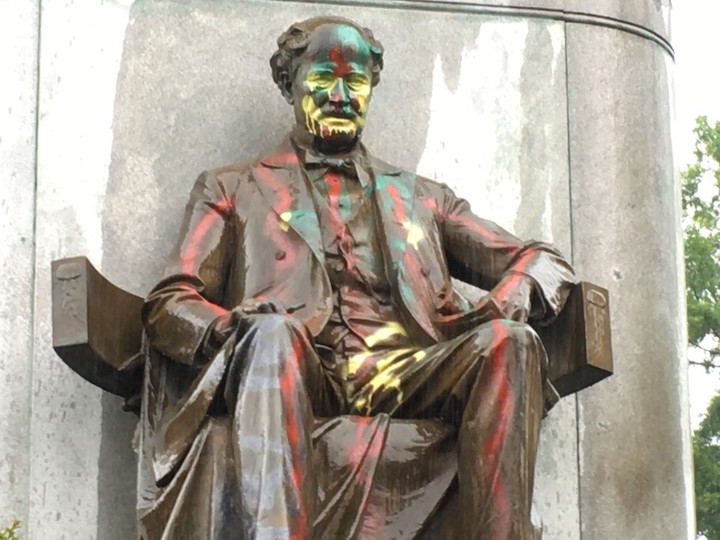
Maury’s eyes have been spray painted yellow, and he’s been given a big yellow smile. There’s some green and red on his head and chest, too, for the full Pan-African color scheme. Someone has also put the obligatory “BLM” across the statue’s base. There’s an anarchy symbol on the side. Then I see what’s probably the most depressing bit of spray painting I’ve seen all day: “Fuck History.”
Isn’t that, after all, part of what’s gotten us into this mess in the first place? Too many people have taken that attitude for too long, and so we don’t even have a common understanding of what happened and how it got us to where we’re at.
The rain begins to lighten as the boys and I head back toward the highway, passing Stonewall Jackson one last time as we leave town. He might be standing there like a stone wall for now, but I’m not sure for how much longer.
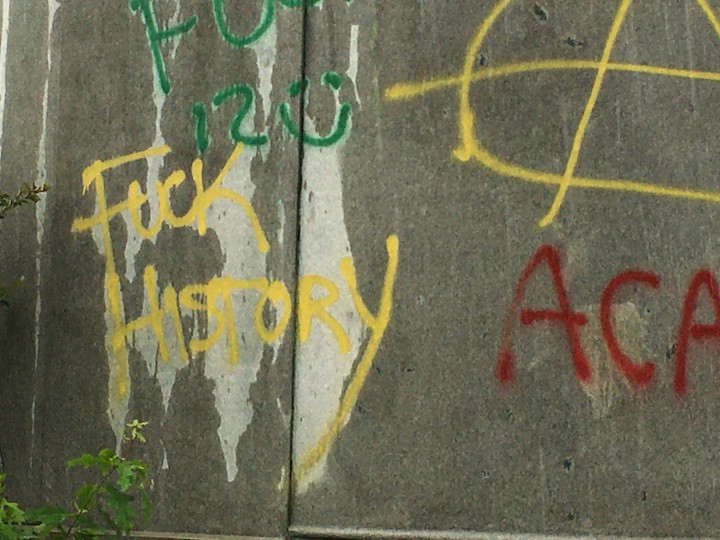
Numb…
Stephanie is right, “That’s terrible.”
Dr. Mackowski, thank you for detailing your trip to Monument Avenue. I only live 65 minutes away, but I hesitate to tour the scene. My father toured it with me 60 years ago, and I was there for the unveiling of the Ashe statue. I may never travel down those paving bricks again. So sad. DFR
You’re welcome, D. I was unsure what I’d see or what the climate would be like, but it was perfectly safe and felt quite literally like a walk in the park. I’m glad I went to see it for myself.
Interesting that my Chinese students tell me that this is a normal practice in their history. Every vestige of the last regime is systematically destroyed.
Ireland has a similar problem. The monuments erected by the Protestant ascendancy remained after 1921. The Admiral Nelson statue was famously blown up at night in downtown Dublin. Fortunately, no one was hurt. But, many memorials and statues still remain. There is a Prince Albert statue tucked away in a distant corner of Dublin. A statue of Walter Raleigh remains in one of the counties. I think the Irish tend not to talk about them in newspapers, so as to provide them some level of protection. But, you find them often. Even more common are the ancient royal coats of arms. The coat of arms appears in cornerstones and over doorways. It would be all but impossible to remove those.
The BLM movement has propelled a lot of change but with the youthfulness of it we get the 1970s all over again. Unfortunately their crudity will engender a mass of new hatred from the right. Will we pay a huge price for it? Probably!
It is probable that no period of major unrest in history—from street demonstrations to revolutions, including our own—has not been accompanied by wretched excess. Think of the French Revolution, which began with such lofty ideals and goals (Liberty, Equality, Fraternity) and then degenerated into an orgy of head rolling, first from the reds, then from the whites; wanton and unnecessary property destruction; looting; rape of nuns; etc. No one decries the wretched excesses now being perpetrated by a minority of protesters than I. Fortunately, as with everything else, they too will pass. For that reason, i.e. their transitory nature, we should not let the mindless, rabid element of protesters, nor their deeds, blind us to the far more important issue as to what direction our country is going to take this fall. With respect to that, think less about mindless excesses and more about where we have been in the last three and a half years, where we are now, and where we want to be.
That’s some excellent context, John. Thank you!
Thanks for doing this. It saddens me that vandalism and destruction of public property is evidently no longer a crime.
Better visit them now, before they’re all pulled down! Not at all unlike the USSR, where all evidence of Trotsky was removed after he fell out with Stalin. Then, ironically, Stalin himself befell the same fate after 1956!
So disheartening…
To all those who deplore defacing and/or tearing down statues honoring Confederate generals and leaders, I recommend they read a column in today’s New York Times. It is written by Caroline Randall Williams, a light-skinned black poet.
She begins her column, “I have rape-colored skin.” Referring to pro-statue preservationists, she writes, “If they want monuments, well, then my body is a monument. My skin is a monument.” Widespread rape was only one of the many horrors inflicted by slave masters on their chattel.
R.E. Lee, Jefferson Davis and all the other Rebel leaders nearly tore our blessed United States of America asunder so slavery could be maintained and expanded. Statues in public venues honoring these men is not only an insult to African-Americans but to all of us.
Lighten up, Francis….sorry, Bob.
What a powerful opening line!
I have an uncle who contracted polio when he was less than two years old. He spent his entire life getting around on crutches and leg braces… but he held a full time job and he drove his own car and he never complained about his lot in life; did not consider himself a victim. And I admire him and enjoyed spending time with him; my favourite uncle. (Jack Maxwell was a Civil War enthusiast who passed away in 2005.)
Thanks, Bob, for bringing to our attention what a REAL victim is all about.
Mike Maxwell
Yes, exactly, Mike. The chick writing about rape colored skin- well, damn, I have rape colored hair. The Vikings landed and raped the British Isles with impunity for a years and years. So should I hate myself because this happened? Can you believe this chick wants to live in a hate filled circle around herself because she doesn’t understand “life?” If everyone in the world seems to want to come to our shores, why? Why? We are a horrible people here in the US, because they have been told this and believe this. We must enslave people and sell people and murder people and wreak havoc on a continual basis, according to the anarchists. So, why would anyone want to be here? Why? Why? Why? These who wish to pull this country down around them, may get their wish. The old adage, “be careful what you wish for, you just might get it” rings true and is truly sad.
It breaks my heart that so many monuments have been destroyed or desecrated. Yes, I do see and “hear” the pain behind all of this; but the sad thing is that the truth of history would perhaps help us all to see and learn from the past. Many of us know what happened, but don’t absorb it as anything but facts. One thing that monuments and museums do is to bring history to life and help us to learn the truths it has to tell us. Even a movie such a GWTW, can draw people in who then may want to learn the truth. A sad fact is that history is barely taught at all, let alone from the perspectives of the various people affected. And as is often true, a little knowledge (minus the actual truth) can be very dangerous. No country in the world hasn’t had times which they look back on with pain and regret. And there are good and bad actors on every “Stage” throughout history. I look at the Civil War and see a country torn apart… people who had families on both sides of the equation… and generals who just a few years before had been classmates at West Point. I also see people who had different values and morals on both sides and great generals on both sides. To me, it is a horrible time in our nation’s history. And yes, slavery itself was a horrible blight on our nation from the beginning. Unfortunately, like little children, we learn to crawl before we walk, and to walk before we run. Decisions were made at the time of the American Revolution that were not meant to be final. Our leaders then knew that all change could not be made at once. We would have to work at each change over time. The problem is that the time for those whose lives were most affected was drawn out far too long. And wounds lie open still. We are far from perfect, but I think the goal is still “to form a more perfect union.” That will take change. But erasing the past will not help us learn the lessons it has to teach us faster; in fact, it will hinder us. Violence, unfortunately, begets violence… never peace. Peace has to come from people willing to meet in the middle and work out from there. Peace comes when trust is created… and right now… that seems like an impossible dream. But we should not give up, just because of the mistakes of the past. We must learn from them; or the experiment called the United States of America may cease to exist.
In her post, Karen Martin lashes out at people “who wish to tear this country down.” I agree wholeheartedly with her. We should never honor people who “wish to tear this country down.” Karen, that’s one of the main reasons I oppose erecting monuments to Confederate generals and leaders. As we all know, they wanted “to tear this country down” so that slavery could be maintained and expanded.
Bob Ruth
I believe what Karen Martin was railing against was “the race to the bottom” – who is worst off, and who is the biggest victim – based merely on claimed ancestral grievances. Somehow, Grand Victim Status bestows prestige in the eyes of some. But, the rule of law works best if applied to living people, not those dead for centuries. Don’t you think?
Thanks for this. My wife and I visited a couple of weeks ago and had much the same experience as you along Monument Avenue. Depressing and discouraging. We also took a look at the old Museum of the Confederacy building which is next to the art museum, just off Monument Avenue. It had been firebombed and the windows were boarded up. Slogans featuring the F word were liberally painted all over it, including one I found particularly strange: “F— the population.” Maury’s monument hadn’t been vandalized as much when we visited as your photo shows now, but someone had spray painted the pedestal in large letters “F— This Guy Too!” (as if he was an afterthought). We tried to visit Capitol Square but it was barricaded off and no one was allowed in. There were lots of broken windows and lots of graffiti including “Will Kill Cop” spray painted on the sidewalk. “Racist Pigs” was spray painted on the Virginia Supreme Court building and there were lots of F bombs spray painted on St Paul’s Church.
Following up on John’s comment above, the experience of the French Revolution does seem increasingly relevant. During the time of the Revolution, the revolutionaries tried to erase all public evidence of France’s monarchical past. All across France hundreds of statues and monuments of kings and royalty were removed or destroyed. In one particularly absurd episode, in October 1793 a Paris mob tied ropes around the 500-year-old statues of the biblical kings of Israel on the facade of the Notre Dame Cathedral, pulled them down, and beheaded them. In Paris alone over 1400 street names were changed (all that had been named for kings or saints). People who shared a name with a monarch or saint changed their name. They changed their children’s names. They changed the names of the chess pieces, to eliminate kings, queens and bishops. They changed the names of playing cards–no more kings and queens. They even changed the name of the queen bee to the “laying bee.” Of course these zealots look ridiculous to us today, but in their zeal they had come to believe that allowing a statue of a historical figure to remain standing was somehow to endorse monarchy or injustice. But each purge would eventually leave the revolutionaries unsatisfied and, like addicts needing ever stronger doses of a drug, they would ratchet up their radicalism. Eventually they turned on their own, attacking those deemed insufficiently radical. Finally the people of France became disgusted with it all, and there was a reactionary backlash. In due course they ended up with Napoleon. In many French churches and cathedrals today there are empty pedestals in the chapels, where statues that were destroyed during the Revolution once stood. That experience is probably why the current French government is taking such a hard line against removal of statues from their colonial period. I think we would do well to keep this historical episode in mind. These kinds of things can easily get out of control.
Thank you so much for this post, Chris. I am left feeling torn – feeling the pain of the protestors and my own pain at the destruction of history. While it is my hope to see these statues relocated to museums or battlefields or cemeteries before they are totally annihilated, I wonder if the impact of the R.E. Lee statue just as it is should remain in place representative of two times in our nation’s history…
I, too, am feeling torn, Patricia. Lots of conflicting things to think about and feel.
Your “two times in history” is not without precedent. The Lincoln Memorial, for instance, not only commemorates Lincoln, but there’s interpretation there about MLK’s speech. In fact, there’s an inscription in the memorial’s steps that mark the spot where King stood. Two significant layers of history there!
The revolution has already begun with the vandals destroying our history, our heritage and our culture without any repercussions from the impotent politicians. They could let the police do their duty in protecting the public and property. ECW watched it coming and supported the removal of historical figures and now it is reaching back to include everyone they deem a threat to minorities, even centuries ago. Good job ECW and all the intellectual historians that didn’t speak up for US history. Perhaps they were intimidated and afraid to be called a racist.
I am pretty certain, Robert, that no one on this site has ever said, Let a mob tear down statues. Some of us, including me, have argued that it’s a community’s right to take a statue down just as it was a community’s right to put a statue up in the first place, although ECW does not have an official position on that because we have historians who have a variety of opinions on that matter.
You seem vehement about defending “US history,” but then you refer to minorities as separate, as though the history does not belong to them or they do not belong to it. Did anyone in Richmond, when these statues were going up, ask those minorities how they felt about them in the first place? What you really seem upset about is that those minorities (who are actually a majority in the city) are now finally having their say, and you don’t like what they’re saying. I, for one, don’t particularly like HOW they’re saying it, but I think they do have a right to express their opinions,
And if you REALLY want to split hairs and defend “US history,” then we’re literally talking about a time during which eleven states fomented rebellion against the U.S., and the U.S. had to put that rebellion down, which quite literally made people who fought against the U.S. traitors to the country. Fortunately, we have a nuanced understanding of all that, but I would ask that you open yourself to other nuances to that history, too.
Chris, I must have missed something, I did not mention anything about minorities as being separate.
“we’re literally talking about a time during which eleven states fomented rebellion against the U.S., and the U.S. had to put that rebellion down.”
1) Why did the U.S. have to put that rebellion down? Why couldn’t the United States have turned its back on the Confederate States, and focused its energies instead on the vast potential of the Western territories.
The North’s population was more than four times’ larger than the South, if you count only whites. It was far more industrialized. And, the western territories were not conducive to the kinds of crops that were traditionally grown with slaves. (Did Lincoln really fear large cotton plantations in the Dakotas?) And the two West Coast states the Union did have in 1861, California and Oregon, were already free states.
How much farther west would the Confederacy have spread? Arizona, perhaps? Northerners would have dominated most of the new Western states.
I’m glad my country did put the Confederate rebellion down—but it didn’t have to. Unless, of course, the real concern Northerners had is that other states in the Union might follow the South’s example and leave. If so, then how strong was the Union, really?
2) As I recall, the Confederacy did not try to destroy the United States of America. It tried to leave it. Again, I’m glad the CSA failed—but leaving an entity and trying to destroy it are two different things.
“I would ask that you open yourself to other nuances to that history, too.”
Agreed. For those of us who see some value in Confederate statues, and the legacy they represent, it would be nice if the nuances that we see in the understanding of the history of the Confederacy be respected.
It is one thing for a local community to say that Statue X should be peacefully removed from the center of its community. It’s another thing to declare that certain aspects of American history are so odious that they may not be shown, or mentioned positively, in public whatsoever.
These statues are memorials to those that have given their lives in defense of their country and people. A democratically elected government, something this country supports around the world, was established, CSA. ECW saw what was coming and didn’t lift a finger to defend American history and so it spreads.
I made a point of taking my son down Monument Avenue the last time we visited. I stopped and explained each general to him. I’m glad I did.
As all this proves, you really can’t fix stupid!
I respectfully disagree that the destruction of these monuments and statues and others in different cities including a statue of Grant and a memorial to the Massachusetts 54th as well as many other who sacrificed their lives to end slavery just shows total ignorance the disgusting drive to just destroy.
Thank you for the enlightening perspective. IMO, you buried the lede: “The hurt—of an entire community, pent up for a century and a half and longer—is more sensed than seen, practically throbbing beneath all those colors.” But history is perspective after all, thus our differences. History is NOT comprised of those pieces of concrete and metal, and we are mistaken to think that history is diminished or suffers by the absence of these monuments to traitors whose objective was a white supremacist confederacy on this continent.
I keep in mind your recent admonition to all of us to ask “How did we reach this juncture?” Those traitors of the confederacy are as much responsible for our present situation as they were responsible for killing loyal Americans before the cessation of military hostilities in 1865. The monuments signified continued allegiance to the white supremacist ideals pursued militarily by those individuals. They cast a long historical arc that has plagued us for too long. Perhaps now with their loss of prominence from “regal” positions we might be able to get on with a far more accurate historical perspective. We can begin a fresh look at history, at long last. In addition to being mindful of your query “How did we reach this juncture?”, when I regard those monuments I think also of “What would have become of us if these traitors had succeeded?” It is difficult to conceive of how much more violent we would be, for we can be sure that there would have been massacre after massacre through the decades if those traitors had prevailed militarily and established the society that they envisioned. The conduct of some of the protesters pales by comparison.
It is sad to see you repeat the response that somehow George Floyd’s outcry or Eric Garner’s outcry “I can’t breathe” disproves the mortal distress they were suffering. I won’t bother to ask an EMT, thank you. No one reasonably expects a differential diagnosis from a medical expert in peer reviewed format in order to appreciate that each man was struggling for his dying breath. It is deeply disappointing to read something like that from you, Mr. Mackowski. That type of response ought not to be fostered by anyone, for we as a society ought not to foster the notion that techniques like that are not fatally dangerous. But that is only one aspect of the “I can’t breathe.” Yes, there is the immediate outcry by the Floyds and the Garners among us. But the other aspect is from others who join the outcry in a different aspect. Here is a perspective from an American military hero who did not commit treason against his country, retired Marine Corps LTG Vincent Stewart, https://www.thecipherbrief.com/column/opinion/please-take-your-knee-off-our-necks-so-we-can-breathe
There are multiple perspectives to be appreciated, from the immediate outcry by Mr. Floyd and Mr. Garner who are in mortal distress, and the perspective from true American heroes like LTG Stewart. Like him, I am all too careful around Police. It shouldn’t be that way, but we are where we are. Recall, too, Sen. Tim Scott’s speeches on the Senate floor in which he has recounted painfully his own encounters far too many times as he has gone about his Senate duties or his everyday life. That, too, is perspective.
Thank you for the note about “ACAB.” I was unaware of that, and will be watchful for it going forward. It was particularly meaningful and helpful to know because the local Police Chief (one of few blacks in our police force) recently commented about the difficulties and frustrations of recruiting minorities for our police. He pointed out that police work is not regarded as attractive, respected employment for minorities. It shouldn’t be that way, but I think the notion “ACAB” may be at work unfortunately. It seems to tie in with what the Chief has said. But it can be so different with changed attitudes, which begin not just in the community but in the force, too. Imagine how much safer would be the good officers if we achieved a different way of policing that was no longer a safe place for the bad officers whose conduct leads to such devastation in communities all across this country, time after time? How many of our recent race related conflagrations have started from a police response? I don’t know, but it seems like far too many. Remember, if the good officers and the Police Unions ask us to not judge the entire force by the few, then why not also apply that principle and not condemn the rightful protesters for the actions of the minority who act violently or destructively? In either context, the few should not be allowed to dishonor the vast majority. More than anyone else, good police officers know who are the bad officers. They work intimately with them every day. They have to dedicate themselves to rooting out the bad just as society at large seeks to do the same.
If we keep in mind your query “How did we get here,” and continue to ask “What might have been” if the traitors had succeeded, maybe we as a society will find a way forward. It is nice to know that we won’t have those traitors casting their white supremacist shadows over us as we try to make our future.
Paul B. Eaglin
Great article and leaves me with much to think about. I’ve been involved with Civil War groups for over 50 eyars – founding secretary for the Civil War Round Table of Australia in Melbourne and we are now 48 years later still going strong. I’ve had seven trips to the U.S. and toured the battelfields, museums and historic building, on the last visit Sam Craghead of the Museum of the Confederacy (ACW Museum) took me down Monument Avenue which I had seen a few times before and as always it looked immaculate, clean and tidy and now it seems such a great pity that coming from overseas to visit placed that we have read about for so long, that so much has changed.
Similar problems occur in Australia with changes to history’s divining moments but we keep on remembering – to change the names of suburbs, schools, roads, parks etc., means to lessen our enjoyment of what has gone on before us. Keep on such good research.
Chris you have written some truly great things recently, the Jackson statue (History v Memory) post was spot on, and this post even more so. Keep it up. I believe we CW folk (historian and buff) can do great service to all sides in the current time, you are leading the way.
I am hurt. As a young boy traveling Monument Avenue I did not know the effect it would have on my future. My continued curiosity to find out what happened to make these generals great drove me to study more about historic battles, and to know more about my own great great grandfather.
I have not been to Richmond in decades. I am so shocked by what I see people have done.
Are these people I should look up to?
Is this how “Black Lives Matter” operates?
“Black Lives Matter” does not matter to me.
Cliff: No, you certainly should not look up to them. They are immature, rabid, misguided, short-sighted and counter-productive and they deserve neither praise nor admiration, but scorn. But neither should you allow them and their deeds, both of which will pass soon enough, to deter you from working for a more perfect Union, a goal which, in fact, is desired and facilitated by those members of the Black Lives Matter movement who decry the excesses of the extremists as much as you and I do. The point has already been made by contributors above, but I repeat it for emphasis. Keep your eye on the goal and think about the relevance of November 3, this year, to that goal. I am intentionally avoiding a political statement in this forum, despite Martin Luther King’s famous statement that “In the end, we will remember not the words of our enemies, but the silence of our friends”, out of respect for the forum. But if you would like a political statement, which I believe will interest you, please email me at jcf@neohio.twcbc.com. Thank you.
Born in the view of Stuart Circle at Stuart Circle Hospital. Always a lover of history and this country. Went to the most historical college in Virginia. Studied, shocker, history…and business. Would you like to know what my most pivotal memory of my father was in my young life in the sixties? My father going to his business in the late night with firearms to ward off any rioters trying to burn his business down on Chamberlayne Avenue in the race riots of that decade. So, this resonates with me at a visceral level. My husband and I have vowed to leave this city and the county surrounding it forever. We, in the meantime, will never spend another red cent inside the city limits. That the mayor, city council, governor and state and US representatives don’t care about how I feel, I don’t care about how they feel. I think, though, that the scene related about protesters trying to get to the mayor where his apartment is, speaks volumes of his cowardice. He can cower in his apartment building, while allowing peace loving and non violent people living on Monument Avenue be subjected to this night after night. He should be pulled out of his lodgings, tarred, feathered and a few other things that would answer for his ineptitude and idiocy. I hope he is made to answer for what he has allowed to let happen. I and my family are leaving. To hell with this and if anyone asks me where I’m from – I’m from the once great, but now lost forever, state of Virginia. Or whatever the anarchists decide to change to name to.
Agree wholeheartedly Karen. The very fabric of America is under assault.
Folks keep calling these edifices “monuments.” But, all the Confederate “monuments” I have seen through North Carolina, Louisiana and Texas are inscribed with the “Lest we forget” sentiment. That makes them memorials, not monuments.
I have always loved martial art, so have always stopped to review the local “monuments” all my 63 years. Through Louisiana, Georgia, the Carolinas, and Texas, have yet to see a Confederate “monument” that did not call on the viewer to remember those who were lost. “Lest we forget,” they often say. That sentiment makes these edifices memorials, not monuments. So, the anger, righteous though it is, strikes me as irrational. It is anger in search of a target. It is unfortunate that mostly innocent memorials must pay for the sins of others.
Thank you so much for your posting
As evidenced in comments above, I denounce attempts to “erase History.” However, one silver lining emerged from the black cloud of statue removals: the contents of the Cornerstone of the Lee Statue (formerly in place on Monument Avenue) and protected inside a copper chest… [via google, search “Cornerstone Contributions, investing in the Confederacy” of 16 March 2022 provided by “DHR – the Virginia Department of Historic Resources.”]